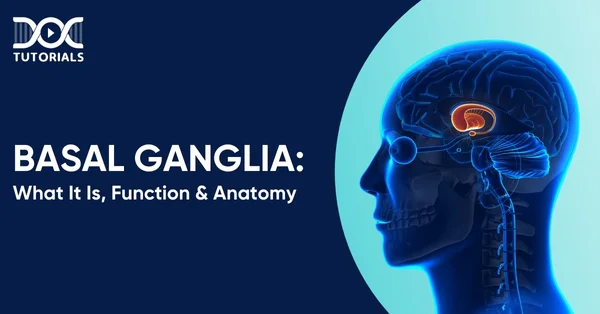Basal Ganglia: What It Is, Function & Anatomy

Knowledge of human neuroanatomy in all its complexity is essential for students preparing for the NEET PG exam as well as medical practitioners. In this regard, one key subject of study is the basal ganglia. To aid in the preparation of this topic, DocTutorials presents the following guide covering a detailed overview of the basal ganglia brain functions and anatomy.
Keep reading for detailed insight!
What is Basal Ganglia?
The basal ganglia are a collection of interconnected subcortical nuclei deep within the cerebral hemispheres, underlying the cerebral cortex. They are involved with the regulation of voluntary motor control, procedural learning, and the performance of habitual behaviours.
Through processing and refining motor signals from the cerebral cortex, the basal ganglia assist in the coordination of smooth and goal-directed movement and also inhibit unnecessary or involuntary movements.
In addition to motor function, they also play a role in emotional control, thinking, and goal-oriented behaviour. In general, the basal ganglia are important both for movement and higher brain function, modifying learned actions and facilitating new skill learning.
What are the Functions of the Basal Ganglia?
The basal ganglia are responsible for a diverse range of essential functions, including motor control, cognition, emotion, and behaviour. Some essential basal ganglia functions include:
- Regulation and Coordination of Voluntary Movement
Basal ganglia play a central role in the regulation of voluntary movement. They screen out movement signals from the cerebral cortex, accepting those that are meaningful or rejecting inappropriate or redundant ones. This assists in optimising motion to provide smooth, regulated muscular action without the recruitment of nearby non-targeted muscles.
- Planning and Modulation of Motor Pathways
By comparing planned movements with sensory feedback from proprioceptive systems, the basal ganglia fine-tune actions that are happening in real-time. This system allows dynamic adjustments during movement, thus facilitating precision and coordination.
- Decision-making and Risk Assessment
The basal ganglia are highly involved in cognitive functions of risk assessment, goal evaluation, and decision-making. These processes are critical to planning tasks, choosing the appropriate action, and performing behaviours according to long-term goals.
- Reward Processing and Motivation
Predominantly under the influence of dopaminergic activity, the basal ganglia assist in modulating the brain’s reward system. Increased extracellular levels of dopamine correlate with feelings of reward and satisfaction (euphoria), whereas reduced levels relate to aversion or diminished motivation.
Reward mechanisms play an important role in learning behaviour, seeking pleasure for outcomes, and establishing long-term habits.
- Learning and Habituation
The basal ganglia process the motivational and affective value of consequences, which makes them important for adaptive behaviour and learning new motor skills. They are also involved in establishing procedural memory and reinforcing habitual behaviour.
- Working Memory and Cognitive Focus
The basal ganglia are involved in transferring sensory input and context information to memory-related cortical regions. This promotes selective attention, memory threshold, and the retention of relevant information in the working memory when performing tasks.
- Emotional and Behavioural Control
These nuclei also play a role in regulating emotion, especially reward and aversion-related emotions. This role is particularly important in disorders like depression, OCD, and addiction, where basal ganglia circuits can become dysfunctional.
- Addiction and Compulsive Behaviours
Due to their support in reward and habit loops, basal ganglia pathway dysfunction, particularly those that are dopaminergic, has been implicated in many addictions.
- Eye Control Movements
The basal ganglia parts, like the caudate nucleus, are involved in the regulation of saccadic eye movements, enabling the ability to fixate upon and track objects visually with accuracy and rapidity. This is crucial for stable vision and visual tracking.
- Integration of Sensory Inputs
Sensory data from modalities such as vision, hearing, touch, and proprioception is transmitted to the basal ganglia to enhance motor responses. Such sensory inputs provide vital feedback that aids in refining and coordinating movement.
What is the Anatomy of the Basal Ganglia?
The basal ganglia are a collection of linked nuclei deep within the cerebral hemispheres at the base of the brain. Find a detailed explanation of the anatomy of basal ganglia in the section below:
- Anatomically, they comprise a number of important structures, such as:
- Caudate nucleus
- Putamen
- Globus pallidus (externus and internus)
- Subthalamic nucleus
- Substantia nigra (pars compacta and pars reticulata)
- Ventral pallidum
- Together, the caudate and putamen constitute the striatum, the primary input centre for virtually all parts of the cerebral cortex. They process such input through separate yet concurrent circuits—motor, limbic, sensory, and associative—that enable the basal ganglia to integrate various information into coordinated outputs.
- The ultimate output nuclei, including the globus pallidus internus and substantia nigra pars reticulata, send processed information to the thalamus, which in turn redirects the same to the target cortical areas.
- This intricate network provides for smooth control of movement, emotion, motivation, and cognition.
FAQs About Basal Ganglia
- How do we prevent problems in the basal ganglia?
While not all diseases affecting the basal ganglia may be prevented, people can mitigate the risks by eating healthy foods, exercising regularly, and avoiding head trauma with the appropriate precautions. Individuals also need to manage chronic diseases as they adversely affect the overall health of the basal ganglia by impacting the function and health of other circulatory and neurological systems.
- What can damage the basal ganglia?
Any neurotrauma can lead to damage of the basal ganglia, including carbon monoxide exposure, drug toxicity, accidental overdose of illicit drugs or overdose of prescription drugs, such as opiates, benzodiazepines, etc.
- Where does the basal ganglia get its blood supply from?
The blood supply to the basal ganglia is largely derived from the lenticulostriate arteries that branch from the middle cerebral artery (MCA).
- What drugs affect the basal ganglia?
Amphetamines are powerful psychostimulants that significantly impact the dopamine levels transmitted through the basal ganglia. Acute and chronic usage could detrimentally affect normal signalling, leading to neurotoxic, movement, or behavioural disorders.
- What is the most common disorder of the basal ganglia?
Although motor disorders are typically linked to the basal ganglia, current studies indicate that issues within the basal ganglia can also result in additional conditions, including obsessive-compulsive disorder (OCD) and Tourette syndrome.
Conclusion
The basal ganglia are an anchor of human neurophysiology, integral to motor control and several cognitive processes. A detailed grasp of their anatomy and function provides medical students with the information necessary to confidently answer exam questions and detect clinical cases.
To assist in this endeavour, DocTutorials provides concise video lectures, live sessions with experts, faculty-reviewed question banks, mock tests, and more. Enrol in our NEET PG courses today!
Latest Blogs
-

NEET SS Exam 2024: Analysis, Key Dates, Counselling
The NEET SS 2024 exam kicked off on March 29, 2025. Over two days and two slots, candidates across 13…
-

NEET PG Registration 2025: An Essential Guide For Exam Prep
The NEET PG registration, which is conducted online, is a crucial step in the exam process. Filling out the NEET…
-

NEET PG Syllabus 2026: A Must-Have Complete Guide for Exam Success
The NEET PG Syllabus acts as one of the foundation stones for aspiring postgraduate medical students like you who are…




